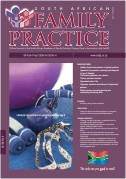Missed Opportunities for Cervical Screening at Eben Donges Hospital and Worcester Community Health Centre Worcester, South Africa
Keywords:
Missed opportunities, cervical (Papanicolaou) smear, screening, primary care
Abstract
Background: Cervical cancer is the only gynaecological malignancy for which a screening modality is widely accepted and recommended to all women 8. The decline in deaths from cervical cancer in the white population in South Africa after the mid-1960s has, similar to the rest of the developed countries, been attributed to cytological screening 11. The purpose of this study was to determine the extent of missed opportunities for cervical cancer screening by the health care service at Eben Donges Hospital and the closely associated Worcester Community Health Centre, for patients 30 years and older, who presented at these centres for reasons unrelated to cervical cancer screening. Methods: A Descriptive Cross-sectional survey was conducted using a questionnaire which was administered through personal interviewing. A sample of 235 patients was selected from 6 sampling units. Sampling was done proportionately, according to the average numbers of patients normally seen at these various units daily. Results: The mean age for the sample was 47 with 30 and 81 being the youngest and oldest patients respectively. The mean level of education for the sample was Grade 7 (Std.5). The overall rate for missed opportunities in cervical cancer screening was 93,2% (95% CI 90%-96%) as only 6.8% of patients were asked about cervical (Papanicolaou) smears during consultation. None of the patients that were seen at the Medical, Surgical and Orthopaedic clinics and Casualty were asked about whether they have had a cervical pap smear, 56,5% (95% CI 36% - 76%) of those patients that were seen at the Gynaecology clinic were asked and 2,3% (95% CI 0.3%- 4.8%) from Worcester Community Health Centre were asked whether they have had a cervical smear. A total of 15.7% [37/235: 95% CI 11%-20%)] never had a cervical smear before and 84.3% (198/235) had a cervical smear performed previously. Of those who had a cervical smear done previously, 51% [101/198: (95% CI 44% - 58%)] had it performed at a local clinic, 40,4% [80/198: (95% CI 34% - 47%)] at a secondary hospital, 5,6% [11/198 (95%CI 2,3% - 8,7%)] privately and 3% [6/198: 995% CI 0,6% - 5,4%)] at a tertiary hospital. Of those patients who had a smear done before (198), 52% [103/198-52% (95% CI 45% - 59%)] were not given an appointment to return for the results, 32% (95% CI 25,8% - 38,8%) did not receive their results and 78.3% (95% CI 72,5% - 84,0%) were not advised regarding further management in future. It is noteworthy that only 2.1% (5/235) of patients had personally requested a cervical smear from a doctor at Eben Donges Hospital and Worcester CHC. A total of 6.8% (16/235) patients were asked during the consultation whether they had a cervical smear done before. On enquiry, a total of 99,2% (95% CI 97,9% - 100%) of patients said that they would have preferred to have received information about a cervical smear from their doctor. Conclusions: Opportunities for cervical cancer screening were missed in patients attending Eben Donges Hospital and Worcester Community Health Centre. Women 30 years and older should routinely be asked about whether they are up to date with their cervical smears irrespective of their presenting complaint. If they are found not to be up to date, they should have a cervical smear done or referred appropriately to their clinics for a cervical smear to be performed. When a smear has been done a follow-up appointment should be given for the results as well as advice regarding when the next smear is due. All such interactions between the patient and the health care worker should be clearly documented in the patient’s record.
Published
2008-06-05
Section
Original Research
By submitting manuscripts to SAFP, authors of original articles are assigning copyright to the South African Academy of Family Physicians. Copyright of review articles are assigned to the Publisher, Medpharm Publications (Pty) Ltd, unless otherwise specified. Authors may use their own work after publication without written permission, provided they acknowledge the original source. Individuals and academic institutions may freely copy and distribute articles published in SAFP for educational and research purposes without obtaining permission.

